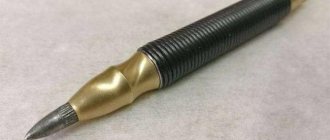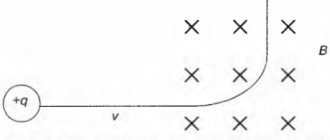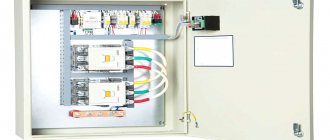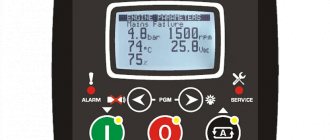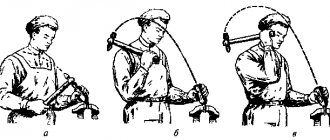Among automatic punches, the most common are manual mechanical ones, which allow you to apply markings with one hand. Most of them use the Sweet mechanism, patented back in 1942.
The operating principle of a mechanical center punch with the Sweet mechanism.
The working cycle of the mechanism of this automatic device includes three stages:
- The sharp end of the rod is installed according to the markings. At this time, the pusher, due to the shape of the front surface of its cap, is in a slightly skewed state and rests its upper end against the edge of the striker. When the body is moved downwards by manual force, the working spring is compressed.
- At the top point, when the spring is fully compressed, the pusher moves from a lateral to an axial position, occupying a place directly opposite the recess in the striker. This is a key feature of this automatic mechanism, for which its inventor received a patent.
- The upper part of the pusher passes into a recess in the striker, the spring is free to move and transmits the accumulated impulse through the striker and pusher to the pointed rod. Since the body of the automatic center punch continues to be held by the mechanic’s hand, all the kinetic energy of the striker will be directed toward breaking through the core hole.
After punching is completed, the device is removed from the surface and the return spring sets the pusher to its original skewed position.
Device and characteristics
As mentioned above, the device is made in the form of a cylindrical rod.
One side is prepared for striking with a hammer, it is called a striker or butt plate, the other is sharpened in the shape of a cone, and the sharpening angle is 120 degrees.
Working with a manual punch is carried out in a simple way: the sharp side of the device is installed at the place where it is planned to drill in the future, and then a blow is struck on the opposite side of the device with a hammer.
The procedure requires some physical effort and time, which is why modern punches are made mechanical or automatic.
The design of a mechanical tool is based on the tight compression of a spring built inside and its subsequent release.
The impact on the butt plate is carried out due to the cocking and trigger mechanism.
In this case, a hammer is not required for applying cores.
In an electric automatic device, work is started due to the action of an electrical circuit built inside the punch.
Moreover, the process takes little time and in one minute the master is able to make at least 50 holes.
Tags: automatic center punch
Comments 19
Damaged drill bit from a hammer drill
It’s normal, depending on what you hammer, the hardened one will sit quickly
Our driller would erase all his fingers like that. There is nothing better than a core from a milling cutter or a tap, which you need to hit with a regular hammer.
The diesel injector needle is even better
We have a lot of taps and cutters XD
No doubt about it)) we don’t have many needles, but I managed to get three of them from the fuel man)) real Amer’s Caterpillars.
The title throws you off at the very beginning. Incredibly annoying. I didn't even look. No likes, no reposts, no subscriptions.
The name is for those who know why the videos are called that.
This irrepressible energy must be directed in the right direction.
Of course, I understand everything, but why saw with a grinder when you have a lathe, and the threads can be cut there too... But regarding the efficiency of this craft, I agree with the comments below. And such a product is not expensive ru.aliexpress.com/item/1-…l?ws_ab_test=searchweb0_0, searchweb201602_5_10152_10151_10065_10344_10068_10342_10343_10340_10341_10543_10084_10083_106 18_10307_10301_5711220_5722320_10313_10059_10534_100031_10103_10624_520_10623_10622_10621_10620_10142_10125, searchweb201603_36, ppcSwitch_ 7&algo_expid=b0337761-3bb0-4c89-b89a-4e8ed823df12-3&algo_pvid=b0337761-3bb0-4c89-b89a- 4e8ed823df12&priceBeautifyAB=0
Of course, I understand everything, but why saw with a grinder when you have a lathe, and the threads can be cut there too... But regarding the efficiency of this craft, I agree with the comments below. And such a product is not expensive ru.aliexpress.com/item/1-…l?ws_ab_test=searchweb0_0, searchweb201602_5_10152_10151_10065_10344_10068_10342_10343_10340_10341_10543_10084_10083_106 18_10307_10301_5711220_5722320_10313_10059_10534_100031_10103_10624_520_10623_10622_10621_10620_10142_10125, searchweb201603_36, ppcSwitch_ 7&algo_expid=b0337761-3bb0-4c89-b89a-4e8ed823df12-3&algo_pvid=b0337761-3bb0-4c89-b89a- 4e8ed823df12&priceBeautifyAB=0
If I'm not mistaken, the student does not support standard threads! 0.8; 1 and 1.2
I think the knob that is directly on the core should be reduced in mass and the impact one should be increased, so the impact force will be stronger due to the increase in the mass of the impactor. And yes, it’s not a bad thing to need news))
Why complicate life so much, it’s easier with a hammer, you can hit weaker, you can hit harder
Convenience and efficiency are questionable (ratio of impact mass to accelerated mass) en.wikipedia.org/wiki/Aut…h_operation_animation.gif
There’s an automatic lying around, we bought it for 150 rubles or something. You hold it like a pen, press down and it slaps, punches.
Source
Types of core samples and their purpose
Types of core differ in their operating principle and main purpose. In the arsenal of locksmiths you can find the following types:
Manual locksmith
Designed for working with metal, tiles, and other types of polished or smooth surfaces.
Center punch compass
It differs from the classic version in that it allows you to make holes at a preset distance.
Kerner bell
Used for punching surfaces shaped like a ball.
Adjustable centering core
The name speaks for itself, the tool can be adjusted.
Mechanical center punch
Allows you to carry out work with one hand and without using a hammer, while the depth of the holes is always the same.
This device is ideal for working with fragile, soft materials.
Automatic center punch
It differs from the mechanical type only in that it contains a solenoid inside itself, which draws a spring-loaded striker into itself, due to which the impact is carried out on the material.
The automatic device is the most convenient to use because it does not require any physical effort.
Homemade core
It is used to work with a wide variety of materials: from plastic to copper, bronze and other types of non-ferrous metals.
For professional use, both an automatic and a classic device are usually purchased, but for home use, when the use of a center punch is required extremely rarely, you can get by with a homemade one.
Punch hammer (Spring punch)
Automatic center punches with the Sweet mechanism (and similar ones) are good because they are very convenient for marking with one hand. But their structure is quite complex; however, there are simpler mechanisms for automatic punching, which are also based on the interaction of a spring and a hammer.
A spring center punch consists of two parts connected by a spring.
In order to punch, you need to pull back the spring and then release it. When the spring is compressed, the metal parts hit each other, resulting in an impact on the surface. This principle is implemented not only in punches, but also in chisels and punchers.
What you need to know about the center punch
When choosing a core sample, you need to remember several important points about this type of instrument.
Firstly, it does not matter at all what cross-sectional shape the tool rod has.
It is much more important to pay attention to its other characteristics.
Secondly, you should buy a device based on the diameter and type of drill with which it will be used.
Thirdly, if you plan to use a center punch when working with soft metals, it is better to choose one with a smaller sharpening angle and vice versa.
Application
First of all, a center punch is used to make indentations (cores) on pre-marked lines. Cores are made so that the marks are clearly visible and are not erased during the processing of the part.
In addition to marking, the center punch is also used to lock (prevent unwinding) threaded connections.
To do this, place one to three core holes in the gap between the threads of the screw and the nut or along the edges of the slot of a countersunk screw. The deformation of the metal that occurs upon impact is sufficient for locking, but allows the threaded connection to be unscrewed using a conventional tool. Another area of use for center punches is impact-point marking. Coding of parts is mandatory for their subsequent processing and identification in assembly production. Usually, specialized pneumatic and electric machines are used for this, but for single production in small volumes, it is quite possible to get by with an automatic mechanical punch.
Applying markings using a center punch
How to use a center punch
Like any other professional tool, all types of center punches require compliance with certain rules for working with them.
Only in this case can we guarantee the best results and safe operation.
While there are ways to rework an incorrect core, they will require more skill than the original hole punching.
Kinds
In addition to differences in manufacturing material and dimensions, the devices can be either manual or used together with an electric tool. The capability of the device and its area of use depend on the type. The following chisels may be found in stores:
- Locksmiths. This is a common option, which is intended for processing an unhardened metal product. This specificity is due to the fact that if used incorrectly, the cutting edge will become dull. When choosing a device of this type, the buyer should pay attention to GOST; a manufacturer who values its reputation indicates it. Therefore, the chisel will meet the requirements.
- Pike. This type is designed to work together with a hammer drill. Its area of application is reinforced concrete, etc. Some experts do not recommend using this type, as torn edges remain.
- Kreuzmeisel. Used to produce keyways and other holes in hard materials. They are rectangular, round and special.
- Kuznechnoye. It has a wooden handle which makes it resemble a hammer. However, it is used for cutting hot metal.
- Spatula. Used for removing plaster. Used together with a hammer drill.
These types are sufficient for working with both metal products and stone, concrete or brick.
Basic Rules
In order to correctly perform the procedure for working with any type of punch, you need:
1. Markings are applied to the material on which holes need to be made.
2. The striking part of the center punch is aligned with the intersection of the marking line.
3. After this, the device is installed strictly perpendicular to the material.
4. Depending on the type of device, impact is applied (with a hammer, using a trigger mechanism or other available method).
If each step is strictly followed, the result of the core will be accurate, and the hole will be of the correct shape, which will allow you to drill an even hole in the future.
Marking tool (punch) from an automobile valve
To drill even holes in metal, you first need to mark the workpiece and also make a guide hole for the drill.
For these purposes, a special marking tool called a center punch is used.
You can buy it at a hardware store or make it yourself from scrap materials.
In today's article we will look at one of the options for a homemade center punch, which was proposed by the author of the YouTube channel CoolDIY.
The main one for homemade products will be a car valve. In this case, the author uses a truck engine valve.
How to choose the right core
To choose the most suitable type of device for yourself, you need to be guided by two factors: your own financial capabilities, the purpose of purchasing the device.
The cheapest type is a regular bench punch, which will be sufficient if you plan to use it in rare cases.
The most expensive type is the electric automatic center punch.
It, as well as mechanized types, are purchased by professional mechanics for daily work.
Material
When choosing the right tool that will last over 5 years, it is important to pay attention to the material. After all, some manufacturers, in order to save money, may use cheap metal, where the working part will become dull after one-time use. To increase the durability parameter, the company produces the device in cast form.
More often, when making tools, carbon tool steel is used, which gives the chisel a hardness of HR 62-63, strength and a good wear rate. The only drawback of the metal is its low heat resistance; heating at 200 degrees is enough for the device to lose its cutting ability. Also, to increase the rate of mechanical wear, the chisel can be made using carbide plates, and the main part from carbon structural steel.
When carrying out chiselling or other stone processing, specialists prefer to work with a chisel made of structural steel. Because this option has increased stability.
The first thing that is important to do when choosing a tool is to determine what types of work it is intended for. To improve performance, hardening of the top layer is also used. It is produced in accordance with established standards. Previously, such tools were made not only from steel, but in some cases aluminum was used. However, during testing it had to be abandoned, since the equipment quickly became unusable and the user needed to spend time on sharpening.
How to make a core with your own hands
You can make the simplest type of tool yourself, using a hexagon as a basis.
At the same time, its striking part is ground, and the tip is sharpened with a certain amount of coal, after which the tool is hardened on both sides.
A regular gas stove is suitable for hardening.
The metal needs to be heated to a bright pink color, and then placed in water for a few seconds, pulled out, and immediately lowered again, but holding the tool in the water a little longer.
This simple type of device is quite suitable for home repairs, and its production will take no more than an hour.
What to make a core from
If among professionals anyone called this tool a core, it ceased to be such by definition. A core or core is a hole in the material - the result of the work of the punch and nothing else.
And also a sample of soil rock obtained in a special way, but this is definitely not the subject of our article.
Now, even Wikipedia presents the word “kern” as the second name for the instrument - puncher, which is fundamentally wrong, but let’s leave this to the conscience of the authors of the material.
Kerner - what is it?
The center punch is a metal rod made of tool steel with a sharpened striking part, sharpened at an angle of predominantly 120° and hardened to a length of 20 - 30 mm, and a striker on the other side, also heat-treated, but 10 - 15 mm. It is also called the butt plate. Used in metalworking to obtain holes or cores necessary for the convenience of drilling material.
Most of the tool remains unhardened, and therefore less fragile, which is done primarily for the purpose of safety of its use.
The cross-sectional shape of the punch rod does not play a special role: it can be round, and then it is often knurled to make it more convenient to hold it in the hand, or maybe hexagonal.
The material of the hexagons is carbon steel, amenable to heat treatment, therefore, if you need to quickly make a center punch at home and find a hexagon with a suitable cross-section, you can safely use it - it will accept hardening without carburization (saturation of the surface layer of steel with carbon).
Punching, in almost all cases, is carried out for subsequent drilling of the material, so that the drill does not slide along the surface of the workpiece at the initial stage of drilling. But there are also options...
Depending on the diameter of the drill, the dimensions of the punch are also selected, but this more often happens in production during mass punching to produce holes of different diameters.
Also, the sharpening angle of the punch may be different, because for soft metals the drill is sharpened at a smaller angle.
Techniques for working with a center punch
There are only two ways of punching: one is correct, the second is incorrect.
For core you need:
That's all, failure to follow these rules will lead to a violation of the accuracy of the core or the shape of the hole, which may cause the drill to move away.
If you made a mistake when punching, then do what no plumbing textbook will advise you to do:
Types of center punches - photos
In addition to the manual version of this tool, there are other varieties of it.
How to restore chrome plating
The factor of obvious increase in the speed of core punching is also important.
4. In an electric punch, an induction coil retracts a spring-loaded firing pin. Everything else is very similar to the mechanical version of the instrument.
How to make a punch with your own hands
For those who do not want to pay 300 - 500 hard-earned rubles for a center punch of more or less normal quality, there are several options for making this tool on your own. We have already mentioned the first one - from a hexagon.
And this can be done even on a regular gas stove, heating the metal until it glows bright pink.
Although it is much faster to do this with a gas torch or a gasoline blowtorch, which, we hope, you already have in your workshop.
You can also quickly make a primitive, but quite workable center punch from an old drill whose side edges have lost their functionality, and therefore cannot be sharpened, by simply sharpening its end.
However, we still do not recommend using such a tool in its pure form - it is very fragile and can break upon impact and cause injury. As a last resort, put a piece of high-pressure hose on it, as in the version in the photo, but better - select a metal sleeve from a tube of suitable diameter or grind it.
In addition to the options mentioned, there is a way to make a center punch from almost any steel, but only carbon steel can be hardened. If you are not sure about the carbon content in it, then you can check this by sparking when processed on a grindstone. And here is the video:
And if you did not see the long-awaited stars when sharpening a suitable rod for making a center punch, then you can carry out the cementation process, which we mentioned at the beginning of the article. There are two ways to do this at home. If you have a welding machine on your farm, then the one shown in the video is the most acceptable and simple.
And if purchasing a welding machine is still in your plans, then look for a nearby metalworking plant where they sharpen cast iron parts and collect cast iron shavings, the smaller the better.
Or buy cast iron powder online. Having heated the metal to the same bright pink glow, lower the part of the workpiece that needs to be quenched into cast iron shavings. The carbon from the cast iron will move into the surface layer of your mild steel and allow it to harden.
The procedure can be repeated several times, but sharpen the center punch before it. However, the instrument can be repaired in the future in the same way.
Required tools and materials
If the metal is sufficiently hard, a drill or self-tapping screw screwed in with a screwdriver can easily slide off the intended point, and in such a situation a large scratch or even a broken drill cannot be avoided. To prevent this from happening, it is customary to make holes or cores, and there is a special tool for this - a center punch!
Penciler - what kind of tool?
The capper is a completely simple device - a steel rod from 100 to 160 mm in length, with a diameter of 8-12 mm.
Rating of the best chisels
TOPEX 03A139
A high-quality model, which is equipped with a plastic apron, is suitable for creating working holes in a concrete structure. Used when working with various hard materials. It is made of durable carbon alloy steel, therefore it has a long service life of more than 8 years. Equipped with an ergonomic handle, which provides comfort when performing various operations, and also protects the hand from accidental contact with a percussion tool.
Total length – 30 cm, weight 690 g.
The average cost is 255 rubles.
TOPEX 03A139
Advantages:
- Value for money;
- Durability;
- Quality work;
- Comfortable handle;
- Safety;
- Alloy steel.
Flaws:
- Not found.
Delo Techniki DT/20/5
The model has a rubberized handle, which eliminates the risk of accidental slipping. The metal part of the structure is made of special hardened steel, which increases resistance to high loads. The device can handle almost any type of work. The hardness is about 63 HR. The handle is pleasant to the touch and ensures 100% human safety.
The width of the working part is 2.2 cm. The total length is 25 cm, with a weight of 500 grams.
The average cost is 500 rubles.
Delo Techniki DT/20/5
Advantages:
- Wear-resistant material;
- Strength;
- Protector on the handle;
- Quality.
Flaws:
- The paint on the middle part wears off quickly;
- Asymmetrical handle.
Hobby 41-1-025
The model is used for cutting and processing thin metal, stone products or concrete surfaces. The main element is made of carbon steel, which ensures a high level of reliability. For operator safety, there is a rubber handle that minimizes the likelihood of an accident.
The weight of the device is 400 grams, so the device fits easily in the hand. Length – 25 cm.
Average cost – 160 rubles.
Hobby 41-1-025
Advantages:
- Price;
- Strength;
- Lever;
- Weight.
Flaws:
- It gets dull quickly.
STAYER 2125
This model is used to remove old concrete coatings. In some cases it is used when working with metal. The working part is made of chrome vanadium steel. Therefore, with proper operation, the service life will be from 5 years. The rubber handle is made of medium quality material, so with prolonged use there is a possibility of damage to the element.
Size – 230 mm, weight – 440 g.
Average cost – 260 rubles.
STAYER 2125
Advantages:
- Price;
- Weight;
- Strength;
- Suitable for concrete and metal;
- Life time.
Flaws:
- The handle may fall off.
Vira 901316
This device will allow users to perform standard operations for processing metal or stone materials. Also, with the help of this chisel you can lay electrical wires in almost every room. The working surface is made of durable carbon steel. The manufacturer claims that the device will last without breakdowns for 6-8 years. The protector is made of high-quality composite material and has a comfortable handle, so the operator can perform ordinary actions without worrying about his hand.
Length – 300 mm. Weight – 550 grams.
The average cost is 600 rubles.
Vira 901316
Advantages:
- Quality of material;
- Durability;
- Weight;
- Price;
- Ergonomic handle.
Flaws:
- Not detected.
What is important to know when working?
A chisel is a common tool that almost every man has. However, despite its simplicity, it requires proper care and use. When working it is important:
- Use only high-quality tools; there should not be even a hint of defects on it. Otherwise, when working with this device, there is a chance of accident or improper handling.
- To check the current condition, a person will need to conduct a visual inspection. This method will allow you to detect such common faults as rust, burrs, etc.
- Periodic sharpening helps increase the service life. It is carried out at an angle for a specific tool.
The product must look like a single structure; humpbacks or traces of poor workmanship are not allowed. Otherwise, a person risks neglecting safety precautions by using a tool in poor condition. This may cause slippage and damage the user's hand.
Main rules
Experts identify 6 main criteria when using this tool. Compliance with them guarantees the safety and quality of processing. These include:
- Visual inspection of the device. The cutting part is sharp and does not need sharpening. There are no burrs.
- The hammer is in good condition. The striking part is securely attached to the handle.
- It is recommended to carry out work using personal protective equipment. For example, glasses, mittens, an apron, etc.
- It is advisable that there is no one in the room, otherwise there is a risk of accidental exposure.
- The equipment used is dry and does not slip out of your hands.
- When working with thick material, cutting at one time is not recommended.
Most models produced recently are equipped with a rubber handle. It prevents the risk of injury if the impact device accidentally slips. The device also promotes uniform energy distribution.
Rating of the best corers
RENNSTEIG RE-430230
An automatic device that will simplify the operator’s work tenfold. The device is made in Germany, so the quality of the steel is at a high level. The center punch does not require a percussion instrument. Holes are created with a simple click. The tip length is 14 mm. Therefore there will be no difficulties. For convenience, the device has an ergonomic rubberized handle. Weight – 95 gr. The device does not require a special case; transportation can take place in a pocket or bag.
Average cost – 2500 rubles.
RENNSTEIG RE-430230
Advantages:
- German quality;
- Easy operation;
- Assembly;
- Wear resistance.
Flaws:
- Price.
JTC 3927
A cheap model from a Taiwanese manufacturer, which is suitable for one-time work. The body of the device is made of chrome-plated steel, so mechanical impact on the punch is not advisable, as chips may form. This material is also more resistant to corrosion, which the user should not forget about. For high-quality holes, the tip of the device is hardened, which allows it not to deform during work. This model has become widespread due to its low cost and relatively good build.
Average price – 800 rub.
JTC 3927
Advantages:
- Convenience;
- Good job;
- Ergonomics;
- There is an adjustment of the impact force.
Flaws:
- Chromed steel;
- Low strength.
BISON Expert 21420-10
A popular device from a Russian manufacturer, which users like because of its affordable price. Impact marks remain clear, the device is fully automated, so there is no need for a hammer or sledgehammer. The total length is 10.5 cm, which allows it to be conveniently transported to any place. The metal structure is made of chrome-molybdenum steel.
The average cost is 500 rubles.
BISON Expert 21420-10
Advantages:
- Quality of holes;
- Price;
- Reliability;
- Compactness.
Flaws:
- Not detected.
STANLEY Center Punch 0-58-120
A manual model that does its job well. The body is made of hardened steel alloy. The tip does not deform over time. With proper use, the device will last for several years. Weight – 50 grams. Length – 10 cm.
The average cost is 200 rubles.
STANLEY Center Punch 0-58-120
Advantages:
- Easy to use;
- Black design;
- Weight;
- Compactness.
Flaws:
- Not detected.
BAHCO 3739H-300
A stylish option that has a plastic handle, so the operator is always safe. The case is made of vanadium steel, so the quality of the device is high. The head part is impact-resistant, therefore, even with a strong impact, the device will withstand the load. Weight – 690 g.
Average cost – 1500 rubles.
BAHCO 3739H-300
Advantages:
- Strength;
- Durability;
- Tread;
- Design.
Flaws:
- Not for all jobs.


